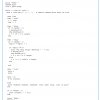 |
Why Do Defects Escape? What happens when defects go unnoticed until it is too late? Mayank provides an insightful view of the true cost of not providing enough test coverage during a software development lifecycle. He also suggests some techniques to ensure that defects are identified and mitigated early.
|
|
 |
You Can't Be Agile without Automated Unit Testing Agile projects assume that test planning, test creation, and test execution take place throughout a project's lifecycle. So the need for unit testing (and especially automated unit testing) can't be ignored and should be considered as a key responsibility of the entire team—not just the software developers.
|
|
 |
Configuration Management: The Ultimate Conductor in the Product Lifecycle When you think of configuration management, build automation and version control usually come to mind. Dave presents a perspective that shows the important role CM plays in the entire product and project lifecycle.
|
|
|
|
Things Change (and So Should Processes) Much like the VCRs of yesteryear, our software development processes are not going to last forever. They’ll fall out of favor, while new and stronger concepts replace them. Jonathan Kohl writes about coping with process evolution in the quest to improve software.
|
|
 |
Strengthen Your Discovery Muscle An organization shouldn’t spend all its time building its delivery muscle without simultaneously building its discovery muscle. In fact, successful software teams deliver great products because they invest in discovery. Learn how to expand your innovation and strengthen your discovery muscle.
|
|
|
|
A Look Behind the Curtain: Debunking 12 Myths of Agile Development When it comes to agile development, Allan Kelly has noticed a lot of misinformation being passed off as fact. In this article, he takes a closer look at twelve of the most common agile myths he has encountered while training new agile teams.
|
|
 |
When Software Smells Bad Most software needs to be "maintainable" and have high "internal quality." But what does that mean in practical terms? Code smells form a vocabulary for discussing code quality and how well suited code might be to change. The smells also provide good indications as to what to refactor and how.
|
|
|
|
Small Experiments: Use Small Software Development Experiments Avoid Big Software Failures In today's software development and test environment, we seem to have little time for either problem identification or solution implementation. What seems to work well instead (and is more fun) is to try small experiments. The idea is not to solve problems, but to try to learn in little steps.
|
|
|
|
License to Open Source Open source is widespread and growing in many software development organizations. While there's no purchase cost, the code does come with license obligations. Understanding open source from an intellectual property perspective can help avoid downstream legal.
|
|
 |
Finding Nuggets in the IT Gold Mine Development teams often are unaware of the commercial impacts of the software improvements they deliver. Often, the prioritization of work is done based on technical, rather than commercial, considerations. Based on a real-world example, this story explores the commercial benefits enabled by delivering in short release cycles and prioritizing according to bottom-line benefits.
|
|

